
Today, the most populous city in the world is Tokyo, with a staggering 38 million people. That makes it the leader of an exclusive group of "mega-cities," or urban areas with more than 10 million people.
Right now there are 28 mega-cities in the world, according to a new report from the United Nations. As of 2014, these are the top 10:
• Tokyo: 38 million
• Delhi: 25 million
• Shanghai: 23 million
• Mexico City: 21 million
• Mumbai: 21 million
• São Paulo: 21 million
• Osaka: 20 million
• Beijing: 19.5 million
• New York–Newark: 18.5 million
• Cairo: 18.4 million
The graph below shows these cities' growth patterns between 1990 and 2030:
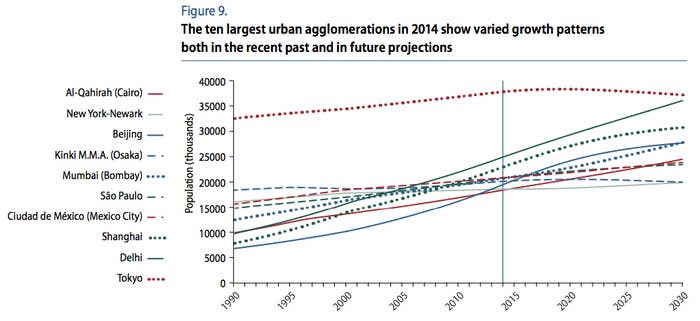
As the graph illustrates, the 10 most populous cities are growing at very different rates. Tokyo is about to peak, while Delhi, Mumbai, and Cairo are all surging upward. The New York metro region, by comparison, has relatively slow but stable growth.
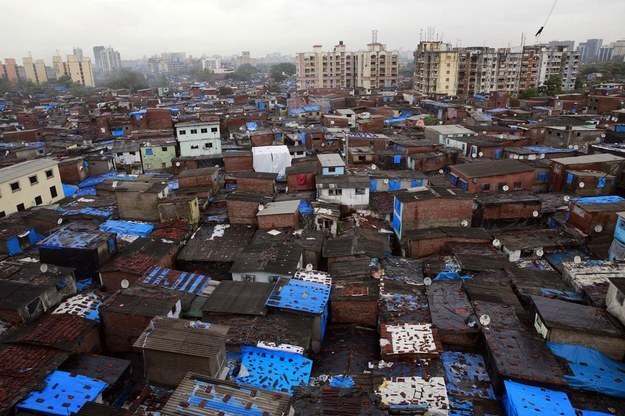
In 1990, only 10 mega-cities existed, but the world's population is urbanizing quickly. By 2030, the U.N. expects the world to have 41 mega-cities.
Tokyo will lose people by 2030 but will remain the most populous urban region in the world. Cities like New York, São Paulo, and Osaka will slip to lower positions on the list of mega-cities as urban populations in the developing world explode. By 2030, these will be the 10 most populous mega-cities:
• Tokyo: 37 million
• Delhi: 36 million
• Shanghai: 31 million
• Mumbai: 28 million
• Beijing: 28 million
• Dhaka: 27 million
• Karachi: 25 million
• Cairo: 24 million
• Lagos: 24 million
• Mexico City: 23 million
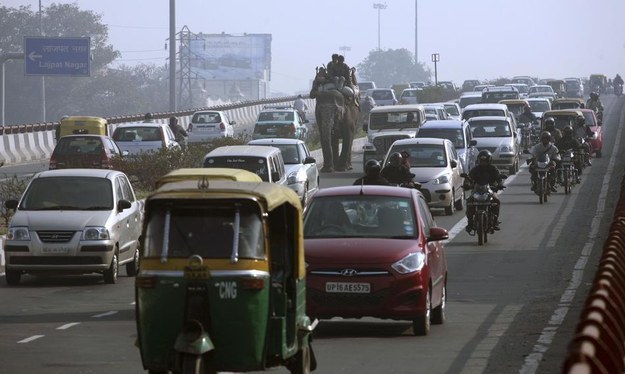
Urban areas joining the mega-city club by 2030 will include Lima, Peru; Bangalore, India; Bogotá, Colombia; Johannesburg, South Africa; and many others.
Though no North American cities will crack the top 10 in 2030, New York City and Los Angeles will continue to grow — albeit comparatively slowly — and will remain on the ever-expanding list. Chicago, with a population of 9.5 million, will fall just short of becoming a mega-city in 2030. Toronto will be Canada's most populous city in 2030 with just under 7 million people.
In Europe, Paris and London have populations of 10.7 million and 10 million, respectively, and will continue to grow slowly until 2030. Moscow has a population of 12 million, which will remain almost unchanged through 2030.* No European urban areas are expected to make the transition to mega-cities by 2030.
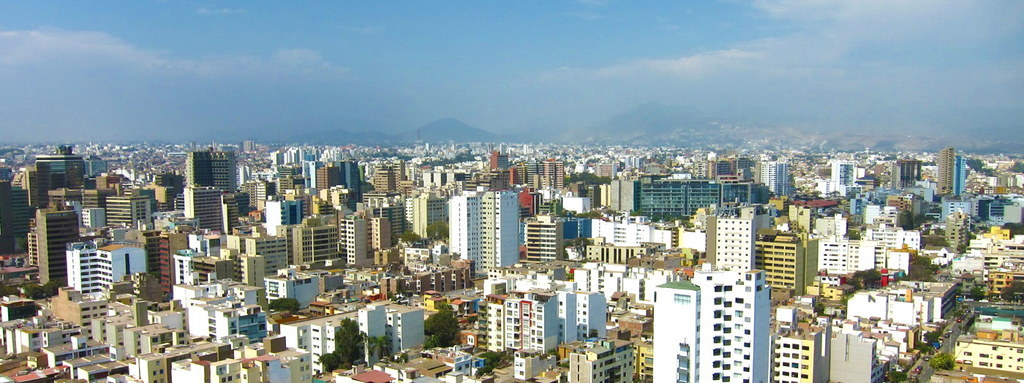
Most people already live in cities now, but by 2030 two-thirds of the world population will reside in an urban area.
In 1950, most of the world was still rural and only 30% of the global population lived in urban areas. By 2030, that figure will more than flip, with 66% of all people living in cities. As of 2014, about 54% of the world lives in an urbanized area. The Americas and Europe are currently the most urbanized regions in the world, but Africa and Asia are urbanizing most quickly.
The report also notes that the worldwide rural population should peak within a few years, remain steady until about 2020, then begin to shrink.
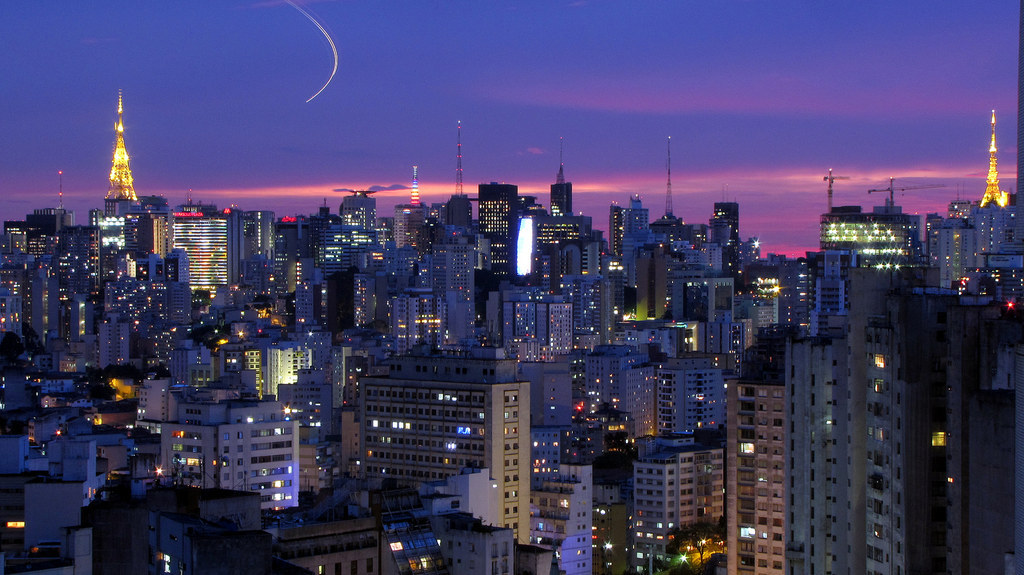
Medium and smaller cities also are growing.
In fact, the report notes that the fastest-growing places are actually cities with less than 1 million people in Asia and Africa. Moreover, while most of the world lives in a city today, almost half of those urban-dwellers live in places with 500,000 or fewer residents.
The graph below shows how urban areas of all sizes have grown since 1990. The takeaway is that while mega-cities are becoming more common, so are smaller and medium-sized urban areas.

The next graph shows the distribution of city types on each continent:
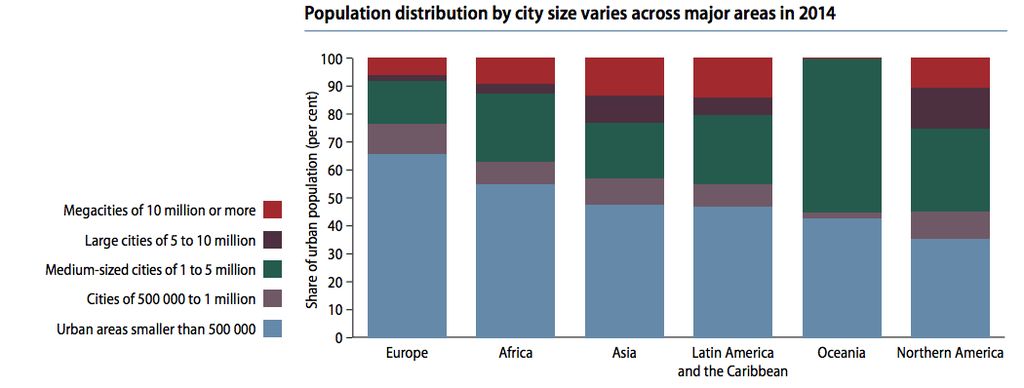
Notable differences from region to region include the large share of smaller urban areas in Europe, the strength of medium-sized cities in Oceania, and the comparatively high share of mega-cities in Asia and Latin America. North America stands out for having a high share of large urban areas that have not yet reached mega-city population levels.

All this urbanization poses an array of challenges, but it can also be a good thing.
The report recommends several general policies aimed at managing this coming growth. Among other things, it singles out incomes, standard of living, sanitation, and transportation as areas on which to focus. Less rich countries that are experiencing fast urbanization rates will feel these challenges most acutely.
Still, if cities do manage this growth well, it may pose an opportunity; the report notes that cities "generate better income and employment opportunities" than other types of development. Cities also make it possible to offer services more efficiently, the report adds. Harvard economist Ed Glaeser has made a similar point, arguing that cities allow people to benefit economically from proximity to one another.
*Moscow originally was not included among the European mega-cities.
